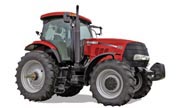
CaseIH Puma 180 Row-Crop tractor Technical Specifications
CaseIH Puma 180 is a Row-Crop tractor that was produced by the John Deere between 2007 – 2010.
Below you will find detailed technical specifications for CaseIH Puma 180 covering engine types, horsepower ratings, weight, height, fuel type and tank volume, oil capacity and type, hydraulic system diagram, wiring diagram, battery specs, etc.
CaseIH Puma 180 Production
| Manufacturer: | |
| Manufacturer: | CaseIH |
| Type: | Row-Crop tractor |
| Factories: | Basildon, England |
| St. Valentin, Austria | |
| Original price: | $130,686 (2010 ) |
| Engine: | |
| Engine: | 180 hp 134.2 kW |
| PTO (claimed): | 150 hp 111.9 kW |
| Drawbar (tested): | 132.7 hp 99.0 kW |
| PTO (tested): | 179.8 hp 134.1 kW |
CaseIH Puma 180 Electrical
| Charging system: | alternator |
| Charging amps: | 150 |
| Battery CCA: | 1300 |
| Battery volts: | 12 |
CaseIH Puma 180 Mechanical
| Chassis: | 4×2 2WD | ||||||||||||||||||||||||||||||||||||||||||||||||||||||||||||||||||||||||||||||||||||||||||||||||||||||||||||||||||||||||||||||||||||||||||||||
| 4×4 MFWD 4WD (optional) | |||||||||||||||||||||||||||||||||||||||||||||||||||||||||||||||||||||||||||||||||||||||||||||||||||||||||||||||||||||||||||||||||||||||||||||||
| Steering: | hydrostatic power | ||||||||||||||||||||||||||||||||||||||||||||||||||||||||||||||||||||||||||||||||||||||||||||||||||||||||||||||||||||||||||||||||||||||||||||||
| Brakes: | differential hydraulic wet disc | ||||||||||||||||||||||||||||||||||||||||||||||||||||||||||||||||||||||||||||||||||||||||||||||||||||||||||||||||||||||||||||||||||||||||||||||
| Trailer brakes: | hydraulic optional | ||||||||||||||||||||||||||||||||||||||||||||||||||||||||||||||||||||||||||||||||||||||||||||||||||||||||||||||||||||||||||||||||||||||||||||||
| Cab: | Cab standard. | ||||||||||||||||||||||||||||||||||||||||||||||||||||||||||||||||||||||||||||||||||||||||||||||||||||||||||||||||||||||||||||||||||||||||||||||
| Transmissions: | 17-speed full power shift | ||||||||||||||||||||||||||||||||||||||||||||||||||||||||||||||||||||||||||||||||||||||||||||||||||||||||||||||||||||||||||||||||||||||||||||||
| 18-speed full power shift | |||||||||||||||||||||||||||||||||||||||||||||||||||||||||||||||||||||||||||||||||||||||||||||||||||||||||||||||||||||||||||||||||||||||||||||||
| 19-speed full power shift | |||||||||||||||||||||||||||||||||||||||||||||||||||||||||||||||||||||||||||||||||||||||||||||||||||||||||||||||||||||||||||||||||||||||||||||||
| continuously variable transmission (CVT) | |||||||||||||||||||||||||||||||||||||||||||||||||||||||||||||||||||||||||||||||||||||||||||||||||||||||||||||||||||||||||||||||||||||||||||||||
Capacity
Hydraulics
Tracktor Hitch
Power Take-off (PTO)
CaseIH Puma 180 Engine detail
CaseIH Puma 180 Dimensions
CaseIH Puma 180 TestsOCED Tractor Test 2423 |
FAQIs CaseIH Puma 180 a good tractor? The CaseIH Puma 180 is one of the great tractors in the CaseIH stable, and it has earned CaseIH a fantastic reputation. How much oil does a CaseIH Puma 180 take? Check out the CaseIH Puma 180 oil capacity and oil type in the engine specs section as it may vary across the engines. Keep in mind, that older models might have their oil capacity increased over time. You may compare between the early and late oil capacity. Do tractors have VIN numbers? Every tractor has a VIN number. The number is usually engraved below the driver’s seat. Tractor manufacturers put the number in different places on the tractor body. What was the last year CaseIH made the Puma 165 The CaseIH Puma 180 was an agricultural tractor model made from 2007 – 2010 | ||||||||||||||||||||||||||||||||||||||||||||||||||||||||||||||||||||||||||||||||||||||||||||||||||||||||||||||||||||||||||||||||||||||||||||||
